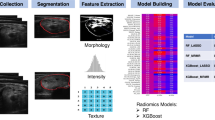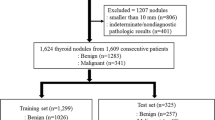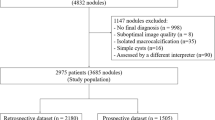Abstract
Objective
To investigate the application of machine learning (ML) model-based thyroid ultrasound radiomics in the evaluation of malignancy in partially cystic thyroid nodules (PCTNs).
Methods
One hundred and ninety-two patients with 197 nodules PCTNs from January 2020 to December 2020 were retrospectively analyzed. Radiomics features were extracted based on hand-crafted features from the ultrasound images, and machine learning methods were used to build a classification model by radiomics features. The least absolute shrinkage and selection operator regression was applied to select the features of nonzero coefficients from radiomics features. The prediction performance of the established model was mainly evaluated by the area under the curve (AUC) and accuracy, sensitivity, and specificity.
Results
Nineteen radiomics features were extracted from the original images for each nodule. Eight ML classifiers were able to differentiate malignancy in PCTNs. The AUC, accuracy, sensitivity, and specificity of k-Nearest Neighbor (KNN) model were 0.909, 82.95%, 83.33%, and 89.90%, respectively, on the test cohort. The comparative result showed statistically equivalent performance for thyroid nodule diagnosis based on image fusion and single image. In addition, the ML-Based ultrasound radiomics system showed a better AUC as compared with ACR TI-RADS model and the ultrasound features model.
Conclusion
The novel ultrasonic-based ML model has an important clinical value for predicting malignancy in PCTNs. It can provide clinicians with a preoperative non-invasive primary screening method for PCTN diagnosis to avoid unnecessary medical investment and improve treatment outcomes.







Similar content being viewed by others
Abbreviations
- PCTNs:
-
Partially Cystic Thyroid Nodules
- ML:
-
Machine Learning
- TI-RADS:
-
Thyroid Imaging Reporting and Data Systems
- LASSO:
-
The least absolute shrinkage and selection operator
- AUC:
-
Area Under the Receiver Operating Characteristic Curve
- KNN:
-
k-Nearest Neighbor
- SVM:
-
Support Vector Machine;
- KNN:
-
k-Nearest Neighbor
- XGBoost:
-
Extreme Gradient Boosting
- MLP:
-
Multilayer Perceptron;
- LR:
-
Logistic Regression
- PPV:
-
positive predictive value
- NPV:
-
negative predictive value
References
R. Wong, S.G. Farrell, M. Grossmann, Thyroid nodules: diagnosis and management. Med J. Aust. 209, 92–98 (2018).
K.D. Burman, L. Wartofsky, CLINICAL PRACTICE. Thyroid Nodules. N. Engl. J. Med 373(24), 2347–2356 (2015).
E.K. Alexander, E.S. Cibas, Diagnosis of thyroid nodules. Lancet Diabetes Endocrinol. 10(7), 533–539 (2022).
B.R. Haugen, E.K. Alexander, K.C. Bible et al. American Thyroid Association Management Guidelines for Adult Patients with Thyroid Nodules and Differentiated Thyroid Cancer: The American Thyroid Association Guidelines Task Force on Thyroid Nodules and Differentiated Thyroid Cancer. Thyroid 2016(26), 1–133 (2015).
F.N. Tessler, W.D. Middleton, E.G. Grant et al. ACR Thyroid Imaging, Reporting and Data System (TI-RADS): White Paper of the ACR TI-RADS Committee. J. Am. Coll. Radio. 14, 587–595 (2017).
T. Zhou, H. Huang, H. Dong, Z. Ni, H. Sun, T. He, C. Ma, Ultrasound-Based Risk Stratification System for the Assessment of Partially Cystic Thyroid Nodules. Endocr. Pr. 29(6), 428–435 (2023).
Y.J. Lee, J.Y. Kim, D.G. Na et al. Malignancy risk of thyroid nodules with minimal cystic changes: a multicenter retrospective study. Ultrasonography 41(4), 670–677 (2022).
Y. Xin, F. Liu, Y. Shi, X. Yan, L. Liu, J. Zhu, A Scoring System for Assessing the Risk of Malignant Partially Cystic Thyroid Nodules Based on Ultrasound Features. Front Oncol. 11, 731779 (2021).
Y.J.B.J. Choi, H.S. Park, W.H. Shim, T.Y. Kim, Y.K. Shong, J.H. Lee, A Computer-Aided Diagnosis System Using Artificial Intelligence for the Diagnosis and Characterization of Thyroid Nodules on Ultrasound: Initial Clinical Assessment. Thyroid 27, 546–52. (2017).
X.Z.S. Li, Q. Zhang, X. Wei, Y. Pan, J. Zhao, X. Xin, C. Qin, X. Wang, J. Li, F. Yang, Y. Zhao, M. Yang, Q. Wang, Z. Zheng, X. Zheng, X. Yang, C.T. Whitlow, M.N. Gurcan, L. Zhang, X. Wang, B.C. Pasche, M. Gao, W. Zhang, K. Chen, Diagnosis of thyroid cancer using deep convolutional neural network models applied to sonographic images: a retrospective, multicohort, diagnostic study. Lancet Oncol. 20, 193–201 (2019)
S. Peng, Y. Liu, W. Lv et al. Deep learning-based artificial intelligence model to assist thyroid nodule diagnosis and management: a multicentre diagnostic study. Lancet Digit Health 3, e250–e9. (2021)
J.M. Park, Y. Choi, H.J. Kwag, Partially cystic thyroid nodules: ultrasound findings of malignancy. Korean J. Radio. 13(5), 530–535 (2012).
T. Zhou, H. Huang, H. Dong, Z. Ni, H. Sun, T. He, C. Ma, Ultrasound-Based Risk Stratification System for the Assessment of Partially Cystic Thyroid Nodules. Endocr. Pr. 29(6), 428–435 (2023).
X. Shi, R. Liu, L. Gao, Y. Xia, Y. Jiang, Diagnostic Value of Sonographic Features in Distinguishing Malignant Partially Cystic Thyroid Nodules: A Systematic Review and Meta-Analysis. Front Endocrinol. 12, 624409 (2021).
W. Li, Q. Zhu, Y. Jiang, Q. Zhang, Z. Meng, J. Sun, J. Li, Q. Dai, Partially cystic thyroid nodules in ultrasound-guided fine needle aspiration: Prevalence of thyroid carcinoma and ultrasound features. Medicine 96(46), e8689 (2017).
Y.Z. Shi, Y. Jin, L. Zheng, Partially cystic thyroid nodules on ultrasound: The associated factors for malignancy. Clin. Hemorheol. Microcirc. 74(4), 373–381 (2020)
B. Zhang, J. Tian, S. Pei, Y. Chen, X. He, Y. Dong, L. Zhang, X. Mo, W. Huang, S. Cong, S. Zhang, Machine Larning-Assisted System for Thyroid Nodule Diagnosis. Thyroid 29(6), 858–867 (2019).
H. Zhou, Y. Jin, L. Dai, M. Zhang, Y. Qiu, K. Wang, J. Tian, J. Zheng, Differential Diagnosis of Benign and Malignant Thyroid Nodules Using Deep Learning Radiomics of Thyroid Ultrasound Images. Eur. J. Radiol. 127, 108992 (2020). https://doi.org/10.1016/j.ejrad.2020.108992.
H. Wu, Z. Deng, B. Zhang, Q. Liu, J. Chen, Classifier Model Based on Machine Learning Algorithms: Application to Differential Diagnosis of Suspicious Thyroid Nodules via Sonography. AJR Am. J. Roentgenol. 207(4), 859–864 (2016).
H.A. Abu Alfeilat, A.B.A. Hassanat, O. Lasassmeh, A.S. Tarawneh, M.B. Alhasanat, H.S. Eyal Salman, V.B.S. Prasath, Effects of Distance Measure Choice on K-Nearest Neighbor Classifier Performance: A Review. Big Data 7(4), 221–248 (2019).
W.C. Lo, P.W. Cheng, C.T. Wang, S.T. Yeh, L.J. Liao, Pain levels associated with ultrasound-guided fine-needle aspiration biopsy for neck masses. Head. Neck 36(2), 252–256 (2014).
C. Cappelli, I. Pirola, B. Agosti, A. Tironi, E. Gandossi, P. Incardona, F. Marini, A. Guerini, M. Castellano, Complications after fine-needle aspiration cytology: a retrospective study of 7449 consecutive thyroid nodules. Br. J. Oral. Maxillofac. Surg. 55(3), 266–269 (2017).
Acknowledgements
Some of our experiments were carried out on the OnekeyAI platform. We thank OnekeyAI and their developers’ help in this scientifific research work.
Funding
The Science and Technology Program of Traditional Chinese Medicine in Zhejiang Province (2022ZA119) and the Zhejiang Medical and Health Science and Technology Plan Project (2021KY927, 2020KY482).
Author information
Authors and Affiliations
Corresponding authors
Ethics declarations
Conflict of interest
The authors declare no competing interests.
Additional information
Publisher’s note Springer Nature remains neutral with regard to jurisdictional claims in published maps and institutional affiliations.
Supplementary Information
Rights and permissions
Springer Nature or its licensor (e.g. a society or other partner) holds exclusive rights to this article under a publishing agreement with the author(s) or other rightsholder(s); author self-archiving of the accepted manuscript version of this article is solely governed by the terms of such publishing agreement and applicable law.
About this article
Cite this article
Zhou, T., Hu, T., Ni, Z. et al. Comparative analysis of machine learning-based ultrasound radiomics in predicting malignancy of partially cystic thyroid nodules. Endocrine 83, 118–126 (2024). https://doi.org/10.1007/s12020-023-03461-0
Received:
Accepted:
Published:
Issue Date:
DOI: https://doi.org/10.1007/s12020-023-03461-0




